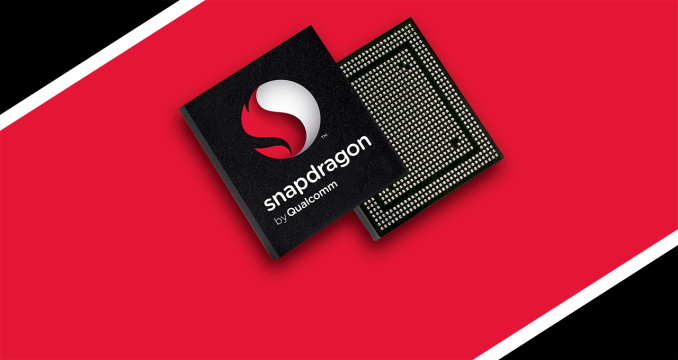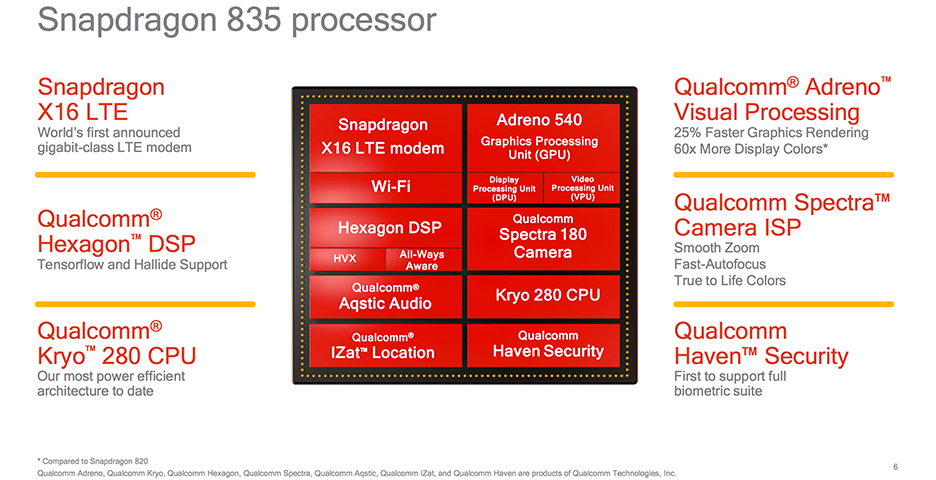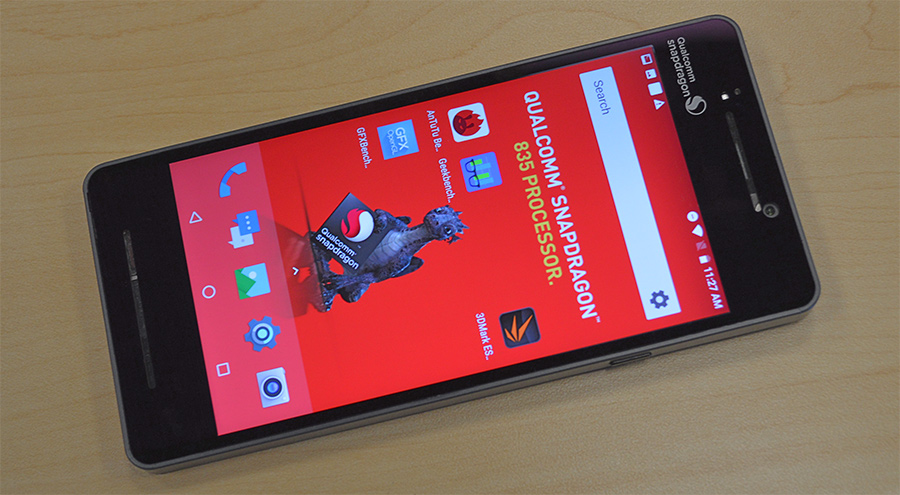The Qualcomm Snapdragon 835 Performance Preview
by Matt Humrick & Ryan Smith on March 22, 2017 4:30 AM EST- Posted in
- Smartphones
- Snapdragon
- Qualcomm
- Mobile
- SoCs
- Snapdragon 835
- Kryo

The Snapdragon 820 SoC was a significant milestone on Qualcomm’s roadmap. It was a solid improvement over the 808/810, delivering higher performance and efficiency, and became a commercial success, finding its way into the majority of flagship phones last year. More importantly, it heralded Qualcomm’s vision for mobile devices: heterogeneous computing. This meant new hardware—a much improved Hexagon 680 DSP that added single instruction, multiple data (SIMD) Hexagon Vector Extensions (HVX); Qualcomm’s first fully-custom 64-bit CPU core, Kryo, which focused on improving floating-point IPC; and an updated Adreno GPU with strong ALU performance—for enabling new software technologies and user experiences—artificial intelligence for smarter personal assistants, machine learning for object recognition, computational photography for better image and video quality, and new AR/VR experiences.
Snapdragon 835—now a part of Qualcomm’s Snapdragon Mobile Platform that includes all of the company’s mobile hardware and software—is an evolutionary product that builds on this vision. The greater than 3 billion transistor SoC is the first to use Samsung’s 10nm "10LPE" FinFET process, which reduces overall package size by 35% relative to Snapdragon 820. The new SoC’s CPU transplant and X16 LTE modem, which tops out at 1Gbps (Category 16) on the downlink, are the biggest changes, but most of the other blocks within the SoC have received at least minor updates too. For detailed information about all the changes and new features, you can read our Snapdragon 835 launch article.
| Qualcomm Snapdragon SoCs: Three Generations | |||
| SoC | Snapdragon 835 (MSM8998) |
Snapdragon 820 / 821 (MSM8996 / MSM8996 Pro) |
Snapdragon 810 (MSM8994) |
| CPU | 4x Kryo 280 Performance @ 2.45GHz 4x Kryo 280 Efficiency @ 1.90GHz |
2x Kryo @ 2.15GHz / 2.34GHz 2x Kryo @ 1.59GHz / 2.19GHz |
4x Cortex-A57 @ 2.00GHz 4x Cortex-A53 @ 1.50GHz |
| GPU | Adreno 540 @ 710MHz ? | Adreno 530 @ 624MHz / 653MHz | Adreno 430 @ 630MHz |
| Memory | 2x 32-bit @ 1866MHz LPDDR4x 29.9GB/s |
2x 32-bit @ 1866MHz LPDDR4 29.9GB/s |
2x 32-bit @ 1600MHz LPDDR4 25.6GB/s |
| ISP/Camera | Dual 14-bit Spectra 180 ISP 1x 32MP or 2x 16MP |
Dual 14-bit Spectra ISP 1x 25MP or 2x 13MP |
Dual 14-bit ISP 1x 21MP |
| Encode/Decode | 2160p30 (2160p60 decode), 1080p120 H.264 & H.265 |
2160p30 (2160p60 decode), 1080p120 H.264 & H.265 |
2160p30 (2160p60 decode), 1080p120 H.264 & H.265 |
| Integrated Modem | Snapdragon X16 LTE (Category 16/13) DL = 1000Mbps 3x20MHz CA, 256-QAM UL = 150Mbps 2x20MHz CA, 64-QAM |
Snapdragon X12 LTE (Category 12/13) DL = 600Mbps 3x20MHz CA, 256-QAM UL = 150Mbps 2x20MHz CA, 64-QAM |
Snapdragon X10 LTE (Category 9) DL = 450Mbps 3x20MHz CA, 64-QAM UL = 50Mbps 1x20MHz CA, 16-QAM |
| Mfc. Process | 10nm LPE | 14nm LPP | 20nm SoC |
In what has become an annual tradition going all the way back to Snapdragon 800, Qualcomm invited the media to its headquarters in San Diego for some feature demonstrations and limited testing using the company's Mobile Development Platform (MDP) devices. These are fully functional tablets or smartphones in a slightly oversized, utilitarian chassis used for hardware testing and software development. The MDP for Snapdragon 810 took the form of a tablet, while Snapdragon 820 came inside a large smartphone with a 6.2-inch display. This downsizing trend continues for Snapdragon 835, whose MDP/S is a smartphone with 6GB of RAM, a 5.5-inch 2560x1440 display, and a small 2850 mAh battery. The use of a smaller chassis is encouraging, because it has less mass and surface area to absorb and dissipate heat. This suggests a lower TDP for the 835, but we'll need to measure power consumption to be sure.
Because we only had a limited time for testing, we focused on running some basic CPU, GPU, and memory performance tests. Keep in mind that we were testing prototype hardware running pre-production software that resulted in a few hiccups. The condensed testing period also forced us to stray slightly from our usual testing methodology. Therefore, these numbers should be viewed as preliminary and could change by the time retail units begin shipping.












128 Comments
View All Comments
joms_us - Saturday, March 25, 2017 - link
And your iPhone with its pathetic 720 display looks crap and sluggish as hell in real world comparison.IlllI - Saturday, March 25, 2017 - link
AMD really missed the boat when they sold their mobile assets to Qualcomm. I often wonder what AMD could have done if they had invested in developing mobile tech all these yearsrealbabilu - Sunday, March 26, 2017 - link
Maybe will be the same as Intel atom mobile did.IlllI - Sunday, March 26, 2017 - link
intel tried years after all these other companies got established. If AMD had gotten in earlier, instead of selling off to Qualcomm, AMD might be Qualcomm todayajohntee - Wednesday, April 12, 2017 - link
Not very possible. Qualcomm is where it's at today because of its early involvement with the CDMA technology and the subsequent development of great Modem chips. They could spend R&D money on their own GPU and cores because of the money coming from selling the whole package including the modem. AMD never had it and seeing how nVidia is struggling still with mobile chips, it's unlikely AMD would've fared much better.SyukriLajin - Thursday, March 30, 2017 - link
regarding 3QA. i'm wondering if it requires special [hardware/firmware] support to use FDD and TD LTE together, or 3QA, by default, supports combining both types of LTE? (this is of course assuming all the other hardware requirement supports 3QA, and the carrier operates on both TD and FDD LTE. I'm wondering because one of the carrier in my country talked about combining both types to get the highest speed, but provides no info if any of the current phone will support it.peevee - Tuesday, April 18, 2017 - link
Why would not you just test Firefox everywhere? Better yet, Firefox with AdBlock installed, so the ads would be uniformly eliminated form the sites. This would allow to compare performance of iPhone hardware. Although the Safari test is also useful as it demonstrates more real life experience of iPhone users which is years ahead of even future Android phones unfortunately.Hrel - Sunday, October 29, 2017 - link
Memory copy, it shows the 821 as being faster yet you have it marked as negative and in red. Yet it's about twice as much bandwidth/second. So, the 821 is really superior in all the areas where it matters, camera performance, speech recognition and memory copy. I'd say the 835 is a pretty big failure. I'll be skipping that SOC entirely.Fix your article though yo.